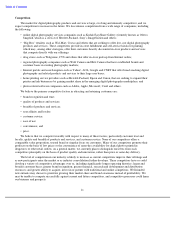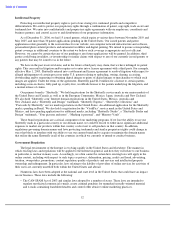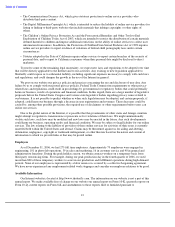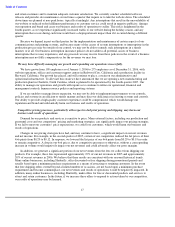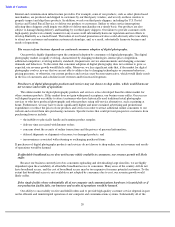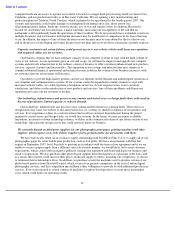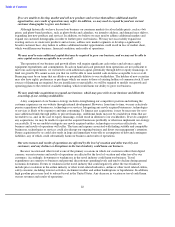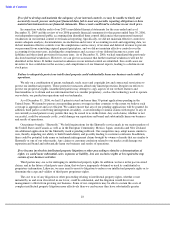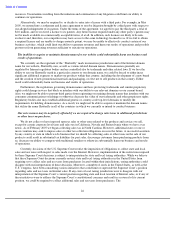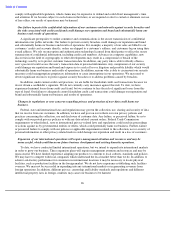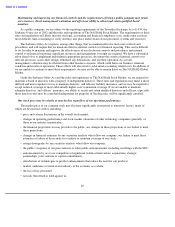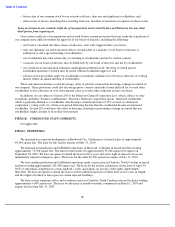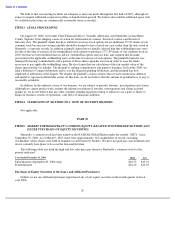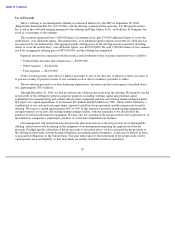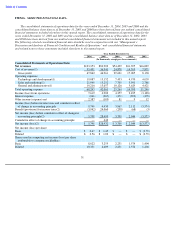Shutterfly 2007 Annual Report Download - page 26
Download and view the complete annual report
Please find page 26 of the 2007 Shutterfly annual report below. You can navigate through the pages in the report by either clicking on the pages listed below, or by using the keyword search tool below to find specific information within the annual report.
Table of Contents
computer hardware necessary to operate our website is located at a single third-party hosting facility in Santa Clara,
California, and our production facility is in Hayward, California. We are opening a new manufacturing and
production plant in Charlotte, North Carolina, which is planned to be operational by the fourth quarter 2007. Our
systems and operations could suffer damage or interruption from human error, fire, flood, power loss,
telecommunications failure, break-ins, terrorist attacks, acts of war and similar events. In addition, Hayward is
located on, and Sunnyvale is located near, a major fault line, increasing our susceptibility to the risk that an
earthquake could significantly harm the operations of these facilities. We do not presently have redundant systems in
multiple locations, and our business interruption insurance may be insufficient to compensate us for losses that may
occur. In addition, the impact of any of these disasters on our business may be exacerbated by the fact that we are
still in the process of developing our formal disaster recovery plan and we do not have a final plan currently in place.
Capacity constraints and system failures could prevent access to our website, which could harm our reputation
and negatively affect our net revenues.
Our business requires that we have adequate capacity in our computer systems to cope with the high volume of
visits to our website. As our operations grow in size and scope, we will need to improve and upgrade our computer
systems and network infrastructure in the ordinary course of business to offer customers enhanced and new products,
services, capacity, features and functionality. The expansion of our systems and infrastructure may require us to
commit substantial financial, operational and technical resources before the volume of our business increases, with
no assurance that our net revenues will increase.
Our ability to provide high-quality products and service depends on the efficient and uninterrupted operation of
our computer and communications systems. If our systems cannot be expanded in a timely manner to cope with
increased website traffic, we could experience disruptions in service, slower response times, lower customer
satisfaction, and delays in the introduction of new products and services. Any of these problems could harm our
reputation and cause our net revenues to decline.
Our technology, infrastructure and processes may contain undetected errors or design faults that could result in
decreased production, limited capacity or reduced demand.
Our technology, infrastructure and processes may contain undetected errors or design faults. These errors or
design faults may cause our website to fail and result in loss of, or delay in, market acceptance of our products and
services. If we experience a delay in a website release that results in customer dissatisfaction during the period
required to correct errors and design faults, we would lose revenue. In the future, we may encounter scalability
limitations, in current or future technology releases, or delays in the commercial release of any future version of our
technology, infrastructure and processes that could seriously harm our business.
We currently depend on third party suppliers for our photographic print paper, printing machines and other
supplies, which exposes us to risks if these suppliers fail to perform under our agreements with them.
We have historically relied on an exclusive supply relationship with Fuji Photo Film U.S.A. to supply all of our
photographic paper for silver halide print production, such as 4×6 prints. We have an agreement with Fuji that
expires in September 2007, but if Fuji fails to perform in accordance with the terms of our agreement and if we are
unable to secure a paper supply from a different source in a timely manner, we would likely fail to meet customer
expectations, which could result in negative publicity, damage our reputation and brand and harm our business and
results of operations. We also purchase other photo-based supplies from third parties on a purchase order basis, and,
as a result, these parties could increase their prices, reallocate supply to others, including our competitors, or choose
to terminate their relationship with us. In addition, we purchase or rent the machines used to produce certain of our
photo-based products from Hewlett-Packard, which is one of our primary competitors in the area of online digital
photography services, and this competition may influence their willingness to provide us with additional products or
services. If we were required to switch vendors of machines for photo-based products, we may incur incremental
costs, which could harm our operating results.
21


